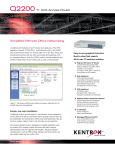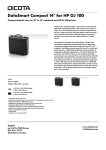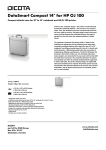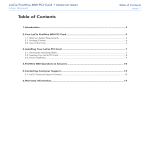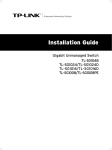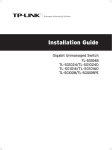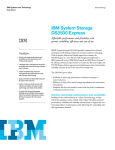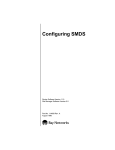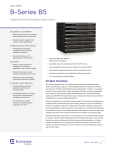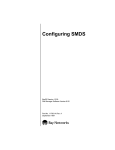Download Kentrox AAC-2TM User's Manual
Transcript
AAC-3 , AAC-2 and CellSMART ® ™ ® Multi-service Access Concentrators CellSMART AAC-3 AAC-2 Features • Scalable architecture provides flexibility as network requirements change AAC™ Multi-service Access Concentrators cost-effectively connect voice, video and data traffic to private Wide Area Networks and public ATM and Frame Relay services worldwide. Supporting multiple protocols, physical interfaces and a wide range of bandwidth requirements, AAC and CellSMART® products allow organizations and service providers to consolidate hybrid facilities for reduced costs and more efficient management of broadband networks. • Multi-service access in a single device reduces recurring monthly access costs • Large variety of available interfaces supply serial ports, Frame Relay and T1/E1, NxT1/E1 IMA, T3/E3, and OC-3/STM-1 to deliver specific services for customer applications • Standards compliance with ATM Forum, Telcordia, NEBS Level 3, ITU-T and Frame Relay Forum ensures multi-vendor interoperability • SNMP and Telnet allow management from local and remote sites • Comprehensive ATM WAN service management for monitoring ATM services ® AAC-3 , AAC-2 , and CellSMART ™ ® ▼ The AAC family comprises three models to deliver a full range of access options at a variety of price points. The AAC-3 offers the highest levels of connectivity and scalability, supporting speeds ranging from T1/E1 to OC-3c/STM-1. Its modular chassis supports up to seven PM/PLM pairs, making it an ideal hubbing device for enterprise networks or a port fan-out device for service distribution. ▼ The AAC family offers a flexible, modular architecture, allowing you to choose the most cost-effective service for each application and manage everything from a single platform. Each AAC contains slots for Protocol Modules (PM) that determine the traffic type—ATM, Frame Relay or Ethernet—and Physical Layer Modules (PLM) that determine the physical interface. The broad array of available Protocol and Physical Layer Modules meets the needs of a variety of customers, including enterprise, service provider, government and military. The AAC-2 provides economical integration of services over public and private networks at speeds ranging from T1/E1 to OC-3c/STM-1. Its smaller chassis supports up to three PM/PLM pairs, making it suitable for mid-sized locations that need to connect voice, video and data traffic to the WAN. ▼ Description The CellSMART 200 IMA series is ideal for medium- to high-speed data applications that require NxT1/E1 access using Inverse Multiplexing for ATM (IMA). A variety of models are available with V.35, HSSI, Ethernet, T3/E3 or OC-3c/STM-1 user ports. The high port density and modular architecture lets each network grow and upgrade at a minimal cost. As service or application needs change, customers just add or switch modules while maintaining a common chassis and management interface. For instance, using an Octal IMA Physical Layer Module, you can steadily add T1/E1 circuits as your bandwidth needs increase. When eight T1 or E1 lines become insufficient, you can switch to a T3/E3 Physical Layer Module. You do not need to replace the Protocol Module, because it can now be paired with the new T3/E3 Physical Layer Module. Central Site ATM LAN Switch Branch Office OC-3c P B X Video T1/E1 T1/E1 OC-3c V.35 T3/E3 AAC-2 V.35 AAC-3 P B X Video Public ATM service or Frame Relays Remote Site NxT1/E1 P B X Router HSSI Data Warehouse T1/E1 HSSI T1/E1 V.35 Router AAC-2 CellSMART 200 Router Figure 1: The AAC family of multi-service access concentrators connects central, branch and remote locations via public ATM or Frame Relay services. www.kentrox.com 800.733.5511 2 AAC-3 , AAC-2 and CellSMART ® ™ ® Applications The wide array of Physical Layer Modules and Protocol Modules supports old and new applications alike. On the user side, legacy interfaces such as V.35/EIA-530 Packet and T1/E1 CBR protect your investment in existing routers, codecs, LAN switches and PBXs. Interfaces such as HSSI, T3/E3 and OC-3c/STM-1 ensure support for newer bandwidthintensive applications. On the network side, AACs connect to WANs at speeds ranging from T1/E1 to OC-3c/STM-1. And to fill the gap between T1/E1 and T3/E3, ATM Forumcompliant Inverse Multiplexing for ATM (IMA) is available. The IMA module aggregates up to eight T1 or E1 lines into a single, logical link operating at up to 16 Mbps. The module uses a round-robin algorithm to divide traffic evenly across multiple links. Furthermore, if one or more links fails, the traffic is automatically redistributed among the remaining links, providing redundancy in the network. The AAC family also offers numerous options for each protocol. For ATM UNI, both the Cell Protocol Module (PM) and the Enhanced Shaping Cell PM are available. The Cell PM is optimized for full throughput on high-speed private networks and local router or switch interfaces. The Enhanced Phy Prot oco l Mo l Lay dule er M s odu les sica Shaping Cell PM is designed for use with public ATM services, shaping each connection to ensure the traffic complies with carrier service level agreements. Multiple PMs are available for Frame Relay services, ATM DXI, PPP and HDLC packet traffic. The Quad Packet and Quad Packet/CBR PMs support packet traffic over T1/E1 and low-speed V.35. The Packet PM supports packet traffic over T3/E3, HSSI, and high-speed V.35. All PMs support Frame Relay Link Management and Frame Relay-to-ATM Service Interworking (FRF.8) and Network Interworking (FRF.5). For circuit emulation, there are four or eight ports of structured or unstructured data transfer options. The Quad Packet/CBR PM supports up to four ports of unstructured circuit emulation on T1/E1 or V.35. The Octal CES PM supports up to eight ports of structured or unstructured T1/E1, up to four ports of unstructured V.35 or one port of unstructured T3/E3 or HSSI. The Octal CES PM also supports an Adaptive Timing option. The Ethernet PM and PLM pair supports RFC 1483/AAL5 bridging with the Spanning Tree Protocol. The modules are designed for full-speed, point-to-point Ethernet connections over ATM. Cell PM Quad Cell PM Enhanced Shaping Cell PM Octal CES PM Packet PM Quad Packet PM Quad Packet/ CBR PM Quad Ethernet PM (10200) (10202) (10204) (10207) (10201) (10205) (10203) (10206) DS3 PLM (10300) • • • • ____________________________________________________________________________________________________ HSSI PLM (10301) • • ____________________________________________________________________________________________________ Quad DSX-1 PLM (10302) • • • ____________________________________________________________________________________________________ Tri V.35/530 & DSX PLM (10303) • • ____________________________________________________________________________________________________ OC-3c/STM1 MM PLM (10304) • • ____________________________________________________________________________________________________ OC-3c/STM1 SM PLM (10305) • • ____________________________________________________________________________________________________ E3 PLM (10306) • • • • ____________________________________________________________________________________________________ Quad E1 PLM (10307) • • • ____________________________________________________________________________________________________ Tri V.35/530 & E1 PLM (10308) • • ____________________________________________________________________________________________________ Quad V.35/530 PLM (10309) • • • • ____________________________________________________________________________________________________ J2 PLM (10310) • • ____________________________________________________________________________________________________ Quad Ethernet PLM (10311) • ____________________________________________________________________________________________________ Octal DSX-1 PLM (10314) • ____________________________________________________________________________________________________ Octal E1 PLM (10315) • ____________________________________________________________________________________________________ Octal DS1 PLM (10317) • ____________________________________________________________________________________________________ Octal DS1 IMA PLM (10318) • • ____________________________________________________________________________________________________ Octal E1 IMA PLM (10319) • • Figure 2: AAC PM/PLM compatibility matrix. www.kentrox.com 800.733.5511 3 ® AAC-3 , AAC-2 , and CellSMART ™ OC-3/STM-1 SM or MM ® T3/E3 J2 IMA T1/E1 T1/E1 V.35, X.21 EIA-530 HSSI Ethernet ATM UNI • • • • • ____________________________________________________________________________________________________ ATM DXI • • • • ____________________________________________________________________________________________________ Frame Relay • • • • ____________________________________________________________________________________________________ HDLC or PPP • • • • ____________________________________________________________________________________________________ SMDS DXI • • • • ____________________________________________________________________________________________________ SMDS SNI • • ____________________________________________________________________________________________________ Ethernet • ____________________________________________________________________________________________________ CBR (CES) • • • • Figure 3: The AAC family supports numerous user and network interfaces. Element Management The AAC family supports local and remote access via in-band or out-of-band connections. All products include an embedded SNMP agent and standard and enterprise MIBs, compatible with SNMP-based management systems. You can also Telnet to the devices via the Ethernet port on the Integrated System Controller or an in-band ATM/Frame Relay connection. The native user interface is menu driven, making port and connection configuration quick and easy. Traffic Management You can maximize the utilization of expensive wide-area bandwidth with AAC traffic management features. The Enhanced Shaping Cell Protocol Module performs traffic shaping on a per-VC and per-VP basis, ensuring that traffic meets the rates contracted with your carrier. This prevents cell discard and retransmissions, improving the overall use of available bandwidth. Connections exit the module through a weighted-fair queuing (WFQ) mechanism that ensures each connection gets scheduled bandwidth, even in the presence of congestion. The system uses early-packet discard (EPD) to reduce congestion quickly and to maximize network utilization. Other AAC modules increase bandwidth utilization by reallocating idle CBR bandwidth. The Octal CES module monitors the CAS voice on/off hook status and V.35/CBR handshake signals. When a www.kentrox.com 800.733.5511 4 connection goes idle, the system can terminate the cell stream so that the bandwidth can be used by other VBR connections. Performance Monitoring AAC systems collect extensive statistics, including port and cell utilization, cell and packet discard, and physical line errors. You can view the information in table or graphical form. With this information you can monitor network performance, anticipate growth in bandwidth requirements and troubleshoot problems in both the local and wide area networks. The products also support a full range of loopbacks including line, local, and payload. In OC-3/STM-1 networks, you can insert BIP and AIS errors to test sections of that link. Standards Compliance AAC products comply with the relevant standards of the ATM Forum, ITU-T, Bellcore/Telcordia, the Frame Relay Forum, and the SMDS Interest Group. This alleviates compatibility issues in multi-vendor networks and reduces the risks associated with proprietary solutions. ATM Forum specification compliance includes ATM UNI 3.0 and 3.1; Traffic Management 4.0 with support for CBR, rt-VBR, nrt-VBR and UBR QoS categories; Circuit Emulation Services 2.0 with support for structured or unstructured CES; and Inverse Multiplexing for ATM (IMA) 1.1/1.0 AAC-3 , AAC-2 and CellSMART ® ™ ® AAC Service Data Module (SDM) Supports ATM Managed Services The Service Data Module for the AAC acts as a Visual Networks® Analysis Service Element (ASE). Specifically designed to support NxT1/E1 IMA or DS3/E3 ATM networks, it monitors user-specified ATM ports and circuits, and communicates service performance data and events to Visual UpTime®. Kentrox and Visual Networks enable service providers to introduce WAN Performance Management Services based on industry-proven hardware and software solutions. Service providers can offer customers a variety of new managed service options and a higher degree of flexibility for hybrid ATM/Frame Relay networks. • Monitors up to 512 VCs • Monitors ATM traffic on user-specified ports and VCs, up to a maximum aggregate rate equivalent to a bi-directional DS3 • Provides data for Visual UpTime Event Processor, Troubleshooting, and Planning and Reporting tool sets • Provides valuable bandwidth utilization details with protocol analysis and top host statistics • Sends SNMP traps regarding AAC events to Visual UpTime Site 1 AAC-2 with SDM Module Frame Relay on HSSI ATM IMA ASE ATM Public Network Site 2 T1 Frame Relay Public Network AAC-2 with SDM Module T1 ASE Frame Relay on HSSI ATM on DS3 T1 ASE Figure 4: AAC acting as an ASE for Visual UpTime. SLA Monitoring The Service Data Module for the AAC can be configured to supply Frame Relay Service Level Agreement (SLA) measurements to Kentrox ServicePoint™ and FrameVision™ devices in ATM and Frame Relay mixed networks. The AAC responds to Frame PING messages (FPING) sent by ServicePoint and FrameVision devices delivering the following: P B X • Round-trip Delay • End-to-end Delay • Frame Delivery Ratio • Data Delivery Ratio • Frames Dropped, Received and Transmitted ServicePoint SDU CBR on DSX-1 T1 Video CBR on V.35 IMA ATM Public Network AAC-2 with SDM Module Frame Relay on HSSI ServicePoint SDU Frame Relay Public Network T1 T1 DataSMART Frame Monitoring DSU/CSU Figure 5: Providing SLA data by responding to FPING messages. www.kentrox.com 800.733.5511 5 ® AAC-3 , AAC-2 , and CellSMART ™ ® Specifications AAC-3 CHASSIS Dimensions (H x W x D): 13.95” x 17.32” x 19” (354.3 x 440 x 482.6 mm) Weight: 60 lbs. (27 kg) Mounting: Available for 19-inch or 23-inch standard equipment racks Operating Temperature: 32º F to 104º F, ambient (0° C to 40° C) Operating Humidity: 5% to 95%, non-condensing AAC-2 AND CELLSMART 200 CHASSIS Dimensions (H x W x D): 6.95” x 17.32” x 19” (176.5 x 440 x 482.6 mm) Weight: 29 lbs. (13.2 kg) Mounting: Available for 19-inch or 23-inch standard equipment racks Operating Temperature: 32º F to 104º F, ambient (0° C to 40° C) Operating Humidity: 5% to 95%, non-condensing EMI/ESD/SAFETY EMI: FCC Part 68, FCC Part 15, Class A, EN55022 Class B Immunity: EN55024 Safety: UL1950, EN60950, CSA 22.2 No 950 - M95 NEBS: Level 3 certified SWITCHING BACKPLANE Cell bus: Dynamic time-allocated, output buffered per port or connection Maximum system throughput: 524 Mbps (1,168,000 cells/second) Connections: 8192 VCCs, 512 VPCs, 512 Multicast POWER SYSTEM AAC-3: Dual redundant power system. Modular power supplies, field replaceable with unit powered. Monitored with alarms/traps on failure. Forced-air cooled. Supports mixed use of AC/DC power modules. AAC-2 and CellSMART 200: Single power system. Modular power supply. Monitored with alarms/traps on failure. Forced-air cooled. Supports use of AC/DC power modules. AC power supply modules: 120/240 VAC (85 to 264 volts), 50/60Hz +/- 3Hz DC power supply modules: -48 VDC (42 to 60 VDC) MANAGEMENT ACCESS Control port: VT100 via RS232 port on front panel (Additional RS232 port on the Integrated System Controller) Ethernet port: SNMP or Telnet In-band: SNMP or Telnet Telnet sessions: Up to 4 concurrently with the Integrated System Controller Common Modules INTEGRATED SYSTEM CONTROLLER (ISC) Clock sources: Internal reference oscillator or recovered from user-specified physical port Clock fallback: User-selectable primary and secondary clock source with automatic fallback and recovery Internal reference: Oscillator Stratum 4 or better Power loss protection: Loss of all input line power will not affect the configuration settings; performance data will be maintained for 12 hours upon loss of power Alarm: Critical, Major, and Minor alarm indicators are viewable from the rear Contact closure for audible and visual alarms ACO (Automatic Cut Off) button disables audible alarms Configuration backup: Pluggable Type II compact flash Management access: Ethernet port and DTE asynchronous port for dial-up modem (in addition to front panel port) www.kentrox.com 800.733.5511 6 AAC-3 , AAC-2 and CellSMART ® ™ ® Common Modules (continued) ALARM MODULE Indicators: Critical, Major and Minor alarm indicators are viewable from the front Alarm: ACO (Automatic Cut Off) button disables audible alarms Configuration backup: Flash SERVICE DATA MODULE (SDM) System indicators: Critical, Major and Minor SDM Indicators: SDM status and monitored traffic Alarm: ACO (Automatic Cut Off) button disables audible alarms and ACO indicator Configuration backup: 1 Mbyte non-volatile configuration on memory controlled by ISC module Traffic monitoring: Monitors up to 512 VCs. Maximum monitoring throughput: Monitors VCs with a maximum aggregate rate equivalent to bi-directional DS3 with 200-byte packets. Traffic greater than bi-directional DS3 is subject to discard. Select Protocol Modules See the PM/PLM compatibility matrix on page 3 for available Protocol and Physical Layer Module combinations CELL PROTOCOL MODULE Protocols supported: ATM UNI, SMDS SNI Connections: 256 VPCs, 4096 VCCs or combinations thereof up to 4096 total connections QoS categories: CBR, nrt-VBR and rt-VBR Output queuing: Separate CBR and VBR output queues with traffic and congestion management capability. Total queue depth: 4700 cells Maximum burst size: 32, 105, 210 or maximum cells Cell emission scheduling: Per port for VBR traffic only or aggregate (CBR and VBR) traffic Congestion management: Early packet discard (EPD) and 4 VBR priorities, CBR not subject to congestion, Partial Packet Discard (PPD) ENHANCED SHAPING CELL PROTOCOL MODULE Protocols supported: ATM UNI Connections: 256 VPCs, 1023 VCCs or combinations of up to 1023 total connections, 94 VPLs QoS categories: CBR, rt-VBR, nrt-VBR, UBR+, UBR Output queuing: Total queue depth 128K cells, allocated between VCCs and VPCs Cell emission scheduling: Per VC for all connections, nrt-VBR, UBR+ and UBR scheduled via a weighted-fair queuing (WFQ) mechanism Congestion management: Partial and early packet discard (EPD) implemented per VC QUAD CELL PROTOCOL MODULE Protocols supported: ATM UNI, SMDS SNI Connections: 256 VPCs, or 1024 VCCs or combinations of up to 1024 total connections QoS categories: CBR, nrt-VBR and rt-VBR Output queuing: Separate CBR & VBR output queues, with traffic and congestion management capabilities Congestion management: Early packet discard (EPD) and 4 VBR priorities, CBR not subject to congestion, Partial Packet Discard (PPD) PACKET PROTOCOL MODULE/QUAD PACKET PROTOCOL MODULE Protocols supported: Frame Relay, ATM DXI, HDLC, PPP, SMDS DXI Frame Relay connections: Packet PM: 2048 VCCs (AAL5) or DLCIs Quad Packet PM: 512 VCCs (AAL5) or DLCIs per port Services supported: FRF.5, FRF.8 (1490 to 1483 translation) and FRLM Congestion management: Partial and early packet discard (EPD) and 4 VBR priorities www.kentrox.com 800.733.5511 7 ® AAC-3 , AAC-2 , and CellSMART ™ ® Select Protocol Modules (continued) OCTAL CES PROTOCOL MODULE Protocols supported: Structured or unstructured circuit emulation over AAL1 Dynamic bandwidth allocation based on CAS signaling, idle code detection, or V.35 control signals Connections: 32 unicast or multicast per port, 256 per module Output queuing: User-selectable depth of CDV absorption queue to 1 ms Clocking: Synchronous or asynchronous (Adaptive) Logical bundles: 1 DS0 to 24 DS0s (T1) or 31 DS0s (E1) QUAD ETHERNET PROTOCOL MODULE Bridging performance: Filtering and forwarding rate: 14,880 pps each direction, each port, half-duplex Address table: 4096 addresses per module (1024 static entries per AAC system) Spanning Tree protocol: Per IEEE 802.1 D LLC Encapsulation: Using AAL 5 per RFC 1483 Select Physical Layer Modules See the PM/PLM compatibility matrix on page 3 for available Protocol and Physical Layer Module combinations OCTAL IMA DS1 AND E1 PHYSICAL LAYER MODULES Interface connector: RJ48C Line rate: T1 - 1.544 Mbps per port E1 - 2.048 Mbps per port IMA rate: T1 - 1.536 to 12.288 Mbps E1 - 1.984 to 15.872 Mbps Differential delay: Up to 200 ms ACP sync cells: User selectable at 32, 64, 128 or 256 cells Link adjustment: Automatic adjustment on link failure or recovery OCTAL DS1, DSX-1 AND E1 PHYSICAL LAYER MODULES Interface connector: RJ48C Line rate: DS1 (includes CSU) - 1.544 Mbps per port DSX-1 - 1.544 Mbps per port E1 - 2.048 Mbps per port Channelization: NxDS0 up to full line rate QUAD DSX-1/E1 PHYSICAL LAYER MODULE Interface connector: DA15 Line rate: DSX-1 - 1.544 Mbps per port; E1 - 2.048 Mbps per port Fractionalization: NxDS0 up to full line rate QUAD V.35/EIA-530 PHYSICAL LAYER MODULE Interface connector: DB25 Electrical: V.35, RS449, EIA-530, X.21 Line speed: 64 Kbps to 2.048 Mbps on each of four ports or up to 8.192 Mbps on one port HSSI PHYSICAL LAYER MODULE Interface connector: TIA/EIA-613 standard 50 position Line speed: 1 Mbps to 52 Mbps Continued on next page www.kentrox.com 800.733.5511 8 AAC-3 , AAC-2 and CellSMART ® ™ ® Select Physical Layer Modules (continued) DS3 AND E3 PHYSICAL LAYER MODULES Interface connector: 75 ohm coaxial BNC Line rate: DS3 - 44.736 Mbps E3 - 34.386 Mbps OC-3C/STM1 SINGLE AND MULTI-MODE PHYSICAL LAYER MODULES Interface connector: Duplex SC Line speed: 155.52 Mbps Wavelength: 1310 nm (single-mode or multi-mode) QUAD ETHERNET PHYSICAL LAYER MODULE Data rates: 10 Mbps (per port) half duplex Number of ports: 4 Interface connectors: RJ4 Ordering Information Description Catalog Number Chassis and Power Supplies AAC-3 Eight Slot Chassis AAC-3 DC Power Supply AAC-3 AC 120 Volt Power Supply AAC-3 AC 240 Volt Power Supply AAC-3 AC 120/240 Volt Power Supply 10000 10101 10100 10102 10103 AAC-2 Four Slot Chassis AAC-2 DC Power Supply AAC-2 AC 120 Volt Power Supply AAC-2 AC 240 Volt Power Supply AAC-2 AC 120/240 Volt Power Supply 10001 10111 10110 10112 10113 Common Modules AAC Alarm Module AAC Service Data Module (SDM) AAC Integrated System Controller with 3.2.0 software 10011 10013 10022-320 Protocol Modules AAC Cell Protocol Module AAC Packet Protocol Module AAC Quad Cell Protocol Module AAC Quad Packet / CBR Protocol Module AAC Enhanced Shaping Cell Protocol Module AAC Quad Packet Protocol Module AAC Quad Ethernet Protocol Module AAC Octal CES/CBR Protocol Module 10200 10201 10202 10203 10204 10205 10206 10207 www.kentrox.com 800.733.5511 9 ® AAC-3 , AAC-2 , and CellSMART ™ ® Ordering Information Description Catalog Number Physical Layer Modules AAC DS3 Physical Layer Module AAC HSSI Physical Layer Module AAC Quad DSX-1 Physical Layer Module AAC Tri V.35/EIA-530/X.21 and one DSX-1 Physical Layer Module AAC OC-3c/STM1 MM Fiber Physical Layer Module AAC OC-3c/STM1 SM Fiber Physical Layer Module AAC E3 Physical Layer Module AAC Quad E1 Physical Layer Module AAC Tri V.35/EIA-530/X.21 and one E1 Physical Layer Module AAC Quad V.35/EIA-530/X.21 Physical Layer Module AAC J2 Physical Layer Module AAC Quad 10Base-T Ethernet Physical Layer Module AAC Octal (8-port) DSX-1 Physical Layer Module AAC Octal (8-port) E1 Physical Layer Module AAC Octal (8-port) DS1 (CSU) Physical Layer Module AAC Octal (8-port) IMA DS1 Physical Layer Module, FW 2.0.0 AAC Octal (8-port) IMA E1 Physical Layer Module, FW 2.0.0 10300 10301 10302 10303 10304 10305 10306 10307 10308 10309 10310 10311 10314 10315 10317 10318-200 10319-200 CellSMART 200 ATM IMA Systems CellSMART 201t, ISC DS1 Octal IMA to HSSI, 120V AC CellSMART 201e, ISC E1 Octal IMA to HSSI, 240V AC CellSMART 202t, ISC DS1 Octal IMA to V.35,(6 Mbps), 120V AC CellSMART 202e, ISC E1 Octal IMA to V.35 (8 Mbps), 240V AC CellSMART 203t, ISC DS1 Octal IMA to 10Base-t, 120V AC CellSMART 203e, ISC E1 Octal IMA to 10Base-t, 240V AC CellSMART 204t, ISC DS1 Octal IMA to OC-3c/STM-1, 120V AC CellSMART 204e, ISC E1 Octal IMA to OC-3c/STM-1, 240V AC CellSMART 205t, ISC DS1 Octal IMA to DS-3, 120V AC CellSMART 205e, ISC E1 Octal IMA to E3, 240V AC 20001-310 20002-310 20003-310 20004-310 20005-310 20006-310 20007-310 20008-310 20009-310 20010-310 www.kentrox.com 800.733.5511 10 AAC-3 , AAC-2 and CellSMART ® ™ ® Ordering Information Description Catalog Number Accessories AAC-3 Fan Tray Assembly (Spare) AAC-3 23" Rack Mount Brackets AAC-2 23" Rack Mount Brackets AAC Blank Panel, 1 Slot (Spare) AAC-3 Blank Panel, Power Supply (Spare) AAC-3 Cable Management Bar AAC-2 Enhanced NEBS Baffle Kit AAC Manual Set, CD (Spare) AAC/CellSMART Planning Guide, printed AAC/CellSMART Installation Guide, printed (spare) AAC/CellSMART User's Guide, printed 10080 10081001 10081010 10082 10084 10087 10088 10090-310 5000548 5000549 5000550 Memory Cards with Software AAC ISC Back-up Software Compact Flash Type 2 AAC Octal IMA Firmware 2.0.0 Compact Flash Type 2 10038-320 10036-200 Power Cords North America, Korea, Taiwan European Community United Kingdom Italy Australia Japan 90000 90001 90002 90003 90004 90005 www.kentrox.com 800.733.5511 11 AAC-3 , AAC-2 and CellSMART ® ™ ® Multi-service Access Concentrators Web Site: www.kentrox.com Phone: 503-643-1681 • Toll Free: 800-733-5511 • Fax: 503-350-6897 Kentrox, LLC., 20010 NW Tanasbourne Drive, Hillsboro, OR 97124 Kentrox, AAC-3, CellSMART and DataSMART are registered trademarks of Kentrox, LLC. AAC, AAC-2, FrameVision, ServicePoint and ServicePoint Manager are trademarks of Kentrox, LLC. Visual Networks and Visual UpTime are registered trademarks of Visual Networks Technologies, Inc. All other products are trademarks of their respective owners. Specifications published here are current as of the date of publication of this document. At any time, you may verify product specifications by contacting our headquarters in Hillsboro. 05-06-015-2 2/03 © 2002-2003 by Kentrox, LLC. All Rights Reserved. An Equal Opportunity Employer.













